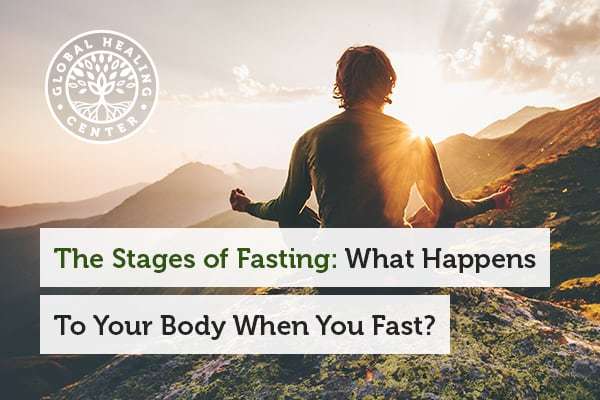
By Dr. Edward Group,
While fasting is nothing new, it is experiencing a resurgence in popularity as many discover its health benefits. If you are planning your first fast or looking for ways to improve your next one, there are a few things you should do to prepare. The first step is learning about the different stages of fasting. This knowledge helps you mentally and physically prepare for what happens to your body when you fast.
The stages of fasting outlined below are based off a water fast, a traditional fast in which you abstain from any food and only drink water for 12-48 hours or longer. Personal experiences can vary depending on the type of fast, age, or health of the individual, but these should give you a general idea of what to expect when you fast.
Stage 1: Day 1-2
Stage one lasts for the first couple of days of the fast or about 12-48 hours from your last meal. Usually, it is a good idea to put some planning and preparation into how and when you will start a fast. Try selecting a start day and time and then make preparations in your schedule for the duration of your fast.
How You Feel: Hungry
This stage is when your body transitions into fasting mode and, for many people, it’s the most challenging part of their fast. This stage is where you start to feel the hunger pains as you skip your regular mealtime routine. Most first time fasters start to feel a reduction in their energy levels. These effects can induce a negative mood or irritability for most fasters. It’s wise to prepare yourself for the possibility of being short on patience during this stage.
What’s Happening With Your Body: Battery Save Mode
Several things happen at the cellular level that cause hunger and fatigue during this first stage. When you’re eating regularly, your body breaks down glucose to get the energy it needs to function properly. While you’re fasting, your body needs to produce sugar for energy, so it begins a process called gluconeogenesis. During gluconeogenesis, your liver converts non-carbohydrate materials like lactate, amino acids, and fats into glucose. As your body goes into “battery save mode,” your basal metabolic rate, or BMR, becomes more efficient and uses less energy. This power saving process includes lowering your heart rate and blood pressure. At this stage, you may feel drained. However, if you stick it out for a little longer, some of that lost energy will return.[1]
Benefits: Mental Strength and Heart Health
Fasting these first few days can be difficult, but there are mental and physical benefits. Mentally, the act of fasting is an excellent way to exercise your willpower. Similar to the strength runners might feel after pushing their body to run that extra mile, people who choose to fast can feel strength as they fight through those natural urges to eat. Physically, there are incredible cleansing and heart health benefits taking place, too. As BMR lowers, fat in the blood starts to disappear as it’s metabolized for energy. This process promotes a healthy heart, and for some, improves cholesterol levels by boosting HDL levels.[2]
Stage 2: Day 3-7
Stage two starts around the end of day two and lasts until day seven. A lot of changes begin to happen at this stage, and you may start to notice changes in your physical appearance, as well as how you feel.
How You Feel: Less Hungry and More Energetic
By stage two, ketosis has begun. Ketosis is a critical phase of the fast where your body starts to burn stored fat as its primary power source. As the processes of ketosis are carried out inside your body, you might stop feeling hungry and tired. The practice of putting your body into ketosis has a growing movement behind it. It is ideal for weight loss, balancing blood sugar, and more. Best of all, you don’t even have to fast to put your body into ketosis. Eating the right foods at the right time can be enough to start this fat burning process. There are even vegan ketogenic diet plans available so you can still eat health-promoting foods to stay in ketosis.
What’s Happening With Your Body: Fat Burning Mode
When you consume a typical diet of carbohydrate rich foods, your body breaks down sugars and starches into glucose. Glucose is the primary source of energy for the body. However, when you fast or go into ketosis glucose becomes limited, and your body must turn to fat stores for the energy it requires. Your body breaks fat down into glycerol and fatty acids. The liver synthesizes ketones using glycerol. The glycerol is broken down by the liver for additional glucose, and finally, those ketones are used by your brain as glucose becomes less available.[1]
Benefits: Weight Loss and Cleansing
Burning fat has several benefits for your health—the first being weight loss. Ketosis is a predictable way to target fat stores that otherwise remain untouched even with a healthy lifestyle. Additionally, getting rid of that extra fat has a detoxifying effect on the body. Your body’s natural defenses use fat stores to store toxic metals and other toxins so they can’t wreak havoc on your system. However, during ketosis, these toxic metals and toxins are safely expelled from your body as fat reserves get used up.[3] This cleansing effect may temporarily alter some people’s complexion or cause other signs of a healing crisis.
Stage 3: Day 8-15
Stage three typically falls between day eight and 15. This stage includes dramatic improvements in mood and mental clarity and is the stage seasoned fasters look forward to the most.
How You Feel: Clear Minded
By the third stage a sort of “fasting high” begins. This boost happens when your body fully adjusts to fasting. While not everyone reaches this stage, those who do report a dramatic improvement in how they feel. These improvements include an elevated mood, increased energy levels, and a type of clear mindedness unique to fasting.
What’s Happening With Your Body: Healing Mode
During stage three, your body starts to enter into a “healing mode.” This healing process begins as your digestive system takes a rest from the common stressors and toxins it endures on a daily basis. As a result, your body has fewer free radicals entering the mix, and oxidative stress decreases.[4]
On the flip side, fasting causes a stress that provides an added benefit. This is a kind of mild stress that is comparable to the stress caused by exercise, which ultimately makes you stronger and your immune system more resilient.[5]
Benefits: Healthy Aging
When the cumulative effects of this stage add up, they can be the catalyst for significant health improvements. Anytime you limit free radicals and oxidative stress you are encouraging healthy aging and positioning yourself for fewer health complications.[6] While less researched, this healing process seems to improve health for some.
Stage 4: Day 16 and Beyond
Stage four occurs sometime around day 16 and continues through the duration of your fast. While there may be some changes moving beyond this juncture, there is a daily balance that starts to set in.
How You Feel: Balanced
If you make it to stage four, you are at a place most have never gone. This stage, while doable, should only be attempted under close supervision from a trusted health care professional. For those that do make it this far, there are not any drastic shifts that occur in how you feel. Instead, a steady balance seems to set in.
What’s Happening With Your Body: Healing Mode Extended
Stage four is the extension and completion of the healing and cleansing processes that began during the earlier stages. The longer you fast, the more time and opportunity your body has to heal and cleanse itself.
Benefits: Personal Goals and Growth
If you make it this far, the benefit becomes personal. Fasting, especially beyond the first seven days, takes steadfast dedication. What you get out of the fast in these later stages can be a culmination of all the earlier stages or an accomplishment of a personal health goal. For some, it is weight loss, for others, it is a strategy to heal a particular health complication.
Stage 5: Breaking the Fast
Stage five may come sooner or later, depending on your fasting goal. While we don’t assign a specific target day, you may want to make breaking your fast a planned event you can look forward to and celebrate when it’s all done.
How You Feel: Accomplished
Whether you fasted for half a day or a full month, you should feel accomplished. Taking deliberate action to improve your health or testing your limits is something worth celebrating.
What’s Happening With Your Body: Easing Out of Fasting Mode
How you choose to end your fast is critical. Depending on how long you fast, you may need to ease your way back into eating solid food. Fruit juices, cooked vegetables, and broths can help acclimate your body and digestive system to eating as internal mechanisms come back online.
Benefits: Start Something New
With careful planning and thought, fasting can be an incredible springboard into a healthier lifestyle. One suggestion is to make plans before you even start your fast. Write down what you’re hoping to get out of it and what you want to accomplish. If done correctly, the end of a fast is the perfect time to begin a dramatically healthier diet and lifestyle.
Additional Fasting Tips
Bowel movements and bad breath are two subjects that most people usually avoid discussing, but when fasting, you need to be aware of both.
During stage one and two of the fast, your body will still be expelling toxins and damaged cells every time you go to the bathroom. Using an intestinal cleansing product, like Oxy-Powder will help more thoroughly cleanse and detoxify your body.
Bad breath will be a concern throughout every stage of a fast. Slightly offensive breath is completely natural and part of the detoxing processes. If you are worried about your breath while you fast, I have created an all-natural solution. It’s called Fresh Mouth, and it comes in a convenient spray bottle that fits in your pocket. Just a few sprays and your mouth will feel fresh and smell great!
Do you have any experience with fasting? Leave a comment below or join the conversation on Facebook, and share your insight with us!
References:
- Fung, Jason, and Jimmy Moore. “The Complete Guide To Fasting.” 1st ed. Las Vegas: Victory Belt Publishing. Print.
- Qujeq, D., Bijani, K., Kalavi, K., Mohiti, J., Aliakbarpour, H. “Effects of Ramadan fasting on serum low-density and high-density lipoprotein-cholesterol concentrations.” Ann Saudi Med. (2002): 297-299
- Chevrier, Dewailly, É. Ayotte, P. Mauriège, P. J-P Després, et al. “Body weight loss increases plasma and adipose tissue concentrations of potentially toxic pollutants in obese individuals.” International Journal of Obesity and Related Disorders; Hampshire24.10 (Oct 2000): 1272-1278.
- Wright, E., J. L. Scism-Bacon, and L. C. Glass. “Oxidative Stress In Type 2 Diabetes: The Role Of Fasting And Postprandial Glycaemia.” International Journal of Clinical Practice 60.3 (2006): 308-314.
- Collier, Roger. “Intermittent Fasting: The Science of Going Without.” CMAJ?: Canadian Medical Association Journal 185.9 (2013): E363–E364.
- Rahman, Khalid. “Studies on Free Radicals, Antioxidants, and Co-Factors.” Clinical Interventions in Aging 2.2 (2007): 219–236.
Recommended articles by Dr. Edward Group:
- The 9 Best Fermented Foods for Your Gut
- 14 Foods that Cleanse the Liver
- Top 5 Foods for the Pineal Gland
- 6 Things You Must Know About Colloidal Silver
- The Importance of a Kidney Cleansing Diet
- The 9 Best Herbs for Lung Cleansing and Respiratory Support
- 7 Best Foods to Support Kidney Function
- Lung Cleansing With Peppermint Oil
- 20 Health Benefits of Fasting for Whole Body Wellness
- How Fluoride Damages Pineal Gland Health
- How Does the Alkaline Diet Affect Gut Health?
About the author:
 Dr. Edward F. Group III (DC, ND, DACBN, DCBCN, DABFM) founded Global Healing Center in 1998 and is currently the Chief Executive Officer. Heading up the research and development team, Dr. Group assumes a hands-on approach in producing new and advanced degenerative disease products and information.
Dr. Edward F. Group III (DC, ND, DACBN, DCBCN, DABFM) founded Global Healing Center in 1998 and is currently the Chief Executive Officer. Heading up the research and development team, Dr. Group assumes a hands-on approach in producing new and advanced degenerative disease products and information.
Dr. Group has studied natural healing methods for over 20 years and now teaches individuals and practitioners all around the world. He no longer sees patients but solely concentrates on spreading the word of health and wellness to the global community. Under his leadership, Global Healing Center, Inc. has earned recognition as one of the largest alternative, natural and organic health resources on the internet.
For more information, please visit Global Healing Center.
Disclaimer: We at Prepare for Change (PFC) bring you information that is not offered by the mainstream news, and therefore may seem controversial. The opinions, views, statements, and/or information we present are not necessarily promoted, endorsed, espoused, or agreed to by Prepare for Change, its leadership Council, members, those who work with PFC, or those who read its content. However, they are hopefully provocative. Please use discernment! Use logical thinking, your own intuition and your own connection with Source, Spirit and Natural Laws to help you determine what is true and what is not. By sharing information and seeding dialogue, it is our goal to raise consciousness and awareness of higher truths to free us from enslavement of the matrix in this material realm.
 EN
EN FR
FR


























